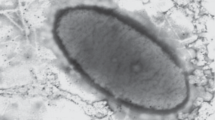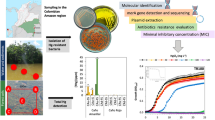Summary
Twenty-six tributyltin (TBT)-resistant bacterial strains isolated from sediments were examined for the presence of plasmids. Plasmids of the size reported to carry metal resistance genes were not found in 15 of the strains, indicating that resistance does not have to be plasmid-mediated. Attempts to cure plasmid-containing strains using acridine organge, ethidium bromide, novobiocin or sodium dodecylsulfate, or by growth at elevated temperature were not successful, nor were plasmids transferred from TBT-resistant strains into TBT-sensitive organisms by electroporation. In a broth mating experiment however, plasmid pUM505, a conjugative plasmid known to encode chromium resistance inPseudomonas aeruginosa PAO1, was introduced into TBT-sensitiveBeijerinckia sp. MC-27 isolated from freshwater sediment. The TBT tolerance of theBeijerinckia sp. increased 100-fold, from 8.4 μM TBT inBeijerinckia sp. MC-27 to 840 μM TBT inBeijerinckia sp. MC-27 (pUM505) on solid medium. The plasmid was transferred at a frequency of approximately 6×10−4. TBT-resistant transconjugants grew faster in media containing TBT and lost their enhanced TBT tolerance and the plasmid upon serial transfer in medium without TBT. Spontaneous mutants of the donorP. aeruginosa lost both TBT resistance and the plasmid. Therefore, TBT resistance in bacteria can be plasmid-mediated. To our knowledge, this is the first report that resistance to a tin compound can be plasmid-mediated.
Similar content being viewed by others
References
Anderson, D.G. and L.L. McKay. 1983. Simple and rapid method for isolating large plasmid DNA from lactic streptococci. Appl. Environ. Microbiol. 46: 549–552.
Avery, S.V., M.E. Miller, G.M. Gadd, G.A. Codd and J.J. Cooney. 1991. Toxicity of organotins toward cyanobacterial photosynthesis and nitrogen fixation. FEMS Microbiol. Lett. 84: 205–210.
Belliveau, B.H., T.S. Wong and J.J. Trevors. 1987. Lead, tin and multiple antibiotic resistantPseudomonas isolated from polluted sediment. Tox. Assess. 2: 377–386.
Birnboim, H.C. and J. Doly. 1979. A rapid alkaline extraction procedure for screening recombinant plasmid DNA. Nucl. Acids Res. 7: 1513–1523.
Cervantes, C. and H. Ohtake. 1988. Plasmid-determined resistance to chromate inPseudomonas aeruginosa. FEMS Microbiol. Lett. 56: 173–176.
Cervantes, C., H. Ohtake, L. Chu, T.K. Misra and S. Silver. 1990. Cloning, nucleotide sequence and expression of the chromate resistance determinant ofPseudomonas aeruginosa plasmid pUM505. J. Bacteriol. 172: 287–291.
Champ, M.A. and W.L. Pugh. 1987. Tributyltin antifouling paints: introduction and overview. Oceans 87 Proc., Vol. 4, pp. 1296–1308, IEEE Service Center, Piscataway, NJ.
Cooney, J.J. 1988. Microbial transformations of tin and tin compounds. J. Ind. Microbiol. 3: 195–204.
Cooney, J.J. 1995. Organotin compounds and aquatic bacteria. Helgoland Meeresuch. 49: (in press).
Cooney, J.J., L. deRome, O. Laurence and G.M. Gadd. 1989. Effects of organotin and organolead compounds on yeasts. J. Ind. Microbiol. 4: 279–288.
Cooney, J.J. and S. Wuertz. 1989. Toxic effects of tin compounds on microorganisms. J. Ind. Microbiol. 4: 375–402.
Crosa, J.H. and S. Falkow. 1981. Plasmids. In: Manual of Methods for General Microbiology (Gerhard, P., ed.), pp. 266–283, Amer. Soc. Microbiol., Washington, DC.
Fukagawa, T. and S. Suzuki. 1993. Cloning of gene responsible for tributyltin chloride (TBTCl) resistance in TBTCl-resistant marine bacterium,Alteromonas sp. M-1. Biochem. Biophys. Res. Commun. 194: 733–740.
Gibbs, P.E., G.W. Bryan and P.L. Pascoe. 1991. TBT-induced imposex in the dogwhelk,Nucella lapillus: geographical uniformity of the response and effects. Mar. Environ. Res. 32: 79–87.
Krone, C.A., D.W. Brown, D.G. Burrows, S. Chan and U. Varanasi. 1989. Butyltins in sediment from marinas and waterways in Puget Sound, Washington State. USA Mar. Pollut. Bull. 20: 528–531.
Lee, R.F. 1991. Metabolism of tributyltin by marine animals and possible linkages to effects. Mar. Environ. Res. 32: 29–35.
Lee, S. and S. Rasheed. 1990. A simple procedure for maximum yield of high-quality plasmid DNA. Biotechniques 9: 676–679.
Mackie, G.L., W.N. Gibbons, B.W. Muncaster and I.M. Gray. 1989. The zebra mussel,Dreissena polymorpha: a synthesis of European experiences and a preview for North America. Environment Ontario, Queen's Printer for Ontario, 75 pp.
Maguire, R.J. and R.K. Tkacz. 1985. Concentration of tributyltin in the surface microlayer of natural waters. Water Pollut. Res. J. Canada 22: 227–233.
Misra, T.K. 1992. Bacterial resistances to inorganic mercury salts and organomercurials. Plasmid 27: 4–16.
Oehlmann, J., E. Stroben and P. Fiorini. 1991. The morphological expression of imposex inNucella lapillus (Linnaeus) (Gastropoda: Muricidae). J. Moll. Stud. 57: 375–390.
Olson, J.E. 1990. An improved method for the rapid isolation of plasmid DNA from wild-type Gram-negative bacteria for plasmid restriction profile analysis. Lett. Appl. Microbiol. 10: 209–212.
O'Rorke, C. (in preparation). Isolation and characterization of a plasmid associated with phenanthrene biotransformation by a coryneform bacterium, CO6. M.S. Thesis, Univ. Massachusetts, Boston, MA.
Pettibone, G.W. and J.J. Cooney. 1986. Effect of organotins on fecal pollution indicator organisms. Appl. Environ. Microbiol. 52: 562–566.
Sambrook, J., E.F. Fritsch and J. Maniatis. 1989. Molecular Cloning: a Laboratory Manual, 2nd edn. Cold Spring Harbor Laboratory, Cold Spring Harbor, NY.
Silver, S. 1992. Plasmid-determined metal resistance mechanisms: range and overview. Plasmid 21: 1–3.
Smith, C. 1990. Bacterial transport of naphthalene in the environment. Masters Thesis, Univ. Massachusetts, Boston.
Speyer, J.F. 1990. A simple and effective electroporation apparatus. Biotechniques 8: 28–30.
Spooner, N., P.E. Gibbs, G.W. Bryan and L.J. Goad. 1991. The effect of tributyltin upon steroid titres in the female dogwhelk,Nucella lapillus, and the development of imposex. Mar. Environ. Res. 32: 37–49.
Summers, A.O. and G.A. Jacoby. 1978. Plasmid-determined resistance to boron and chromium compounds inPseudomonas aeruginosa. Antimicrob. Agents Chemother. 13: 637–640.
Suzuki, S., T. Fukagawa and K. Takama. 1992. Occurrence of tributyltin-tolerant bacteria in tributyltin- or cadmium-containing seawater. Appl. Environ. Microbiol. 58: 3410–3412.
U.S. Public Law 100-330 102 Stat. 605. Organotin antifouling paint control act of 1988, June 16, 1988.
Wade, T.L., B. Garcia-Romero and J.M. Brooks. 1990. Butyltins in sediments and bivalves from U.S. coastal areas. Chemosphere 20: 647–662.
Walter, M.V., A. Porteous and R.J. Seidler. 1987. Measuring genetic stability in bacteria of potential use in genetic engineering. Appl. Environ. Microbiol. 53: 105–109.
Wuertz, S., M.M. Doolittle, M.E. Miller, J.F. Brennan and J.J. Cooney. 1991. Butyltins in estuarine sediments two years after tributyltin use was restricted. Chemosphere 22: 1113–1120.
Wuertz, S., C.E. Miller, R.M. Pfister and J.J. Cooney. 1991. Tributyltin-resistant bacteria from estuarine and freshwater sediments. Appl. Environ. Microbiol. 57: 2783–2789.
Author information
Authors and Affiliations
Rights and permissions
About this article
Cite this article
Miller, C.E., Wuertz, S., Cooney, J.J. et al. Plasmids in tributyltin-resistant bacteria from fresh and estuarine waters. Journal of Industrial Microbiology 14, 337–342 (1995). https://doi.org/10.1007/BF01569948
Received:
Accepted:
Issue Date:
DOI: https://doi.org/10.1007/BF01569948




